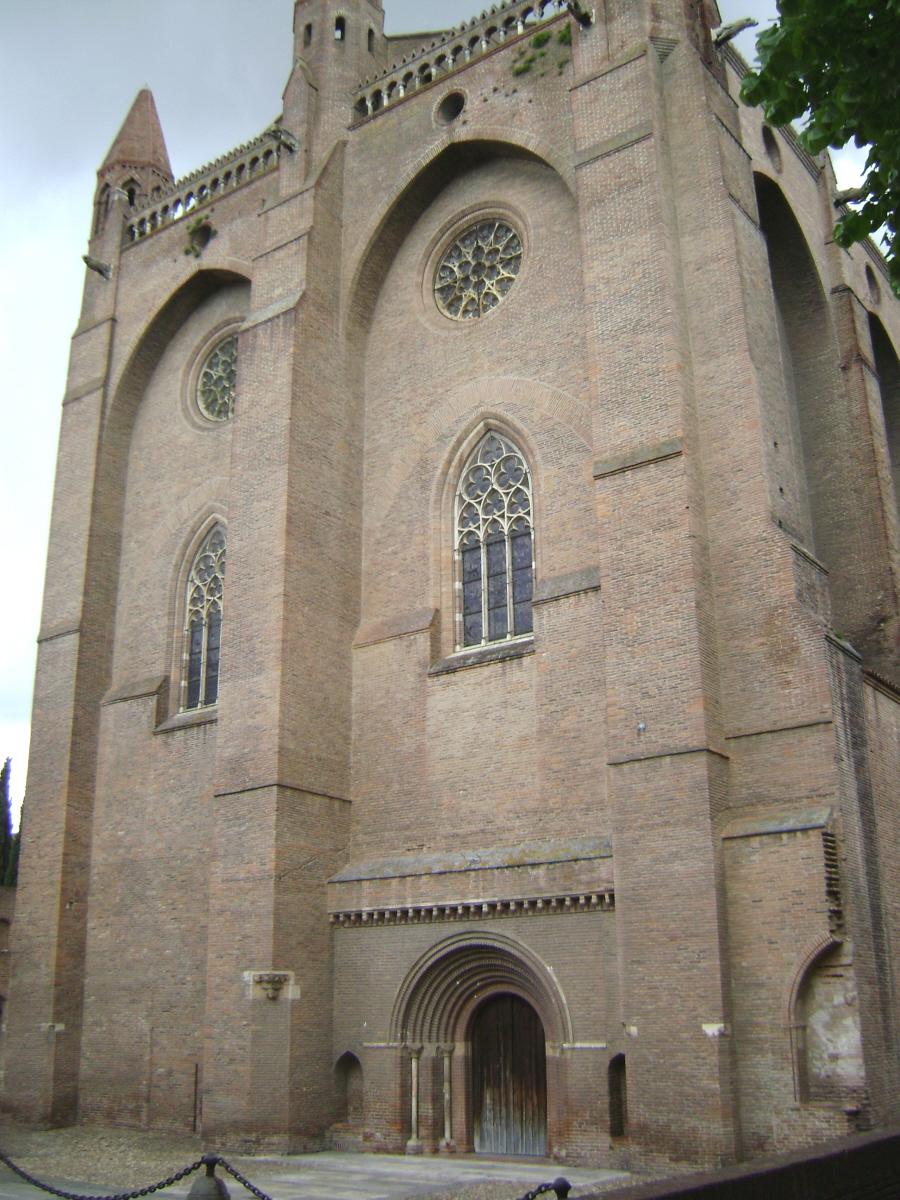To the Église des Jacobins, Toulouse, France, in the year 1369.
View Larger Map
Text from Placid Conway, OP - St. Thomas Aquinas
Online Source: University of Notre Dame's "The Jacques Maritain Center"
CHAPTER X: TRANSLATIONS OF HIS RELICS.
FROM the day of his departure, petitions were addressed to the Holy See for the privilege of possessing his incorrupt body: the King of Sicily and the Counts of Aquino and San Severino did so by title of kinship, the Universities of Paris and Naples by reason of his services rendered in life, and his own Order by right of sonship. The Cistercians of Fossa Nuova, however, kept their treasure for close upon a century; since their church had become a sanctuary renowned for miracles, they refused to part with what Providence had sent them.
In October, 1274, Abbot James and two monks secretly removed the body to St. Stephen's Chapel in the cloister, for which the saint rebuked them in a dream: incautiously they opened the coffin, whereupon a marvellous perfume exhaled which penetrated the cells and church, and the deceit practised was exposed. All saw him as if but reposing in sleep: as they carried him back to the church a marvellous light shone around. Abbot Peter translated the body to a befitting tomb in the choir in 1279, situated on the Gospel side of the high altar. The right hand, still perfectly intact and giving forth a delightful odour, was cut off in 1284 and bestowed on his sister the Countess of San Severino, who placed it in a silver reliquary: her son, Thomas, afterwards gave it to the Dominicans of Salerno.
"And where then have you ordered it to be deposited?" pursued the Pontiff. "Nowhere, Most Holy Father: that shall be as you decide." Nothing was then decided; within a few days the Court moved to Montefiascone, at Whitsuntide, whither Father Elias followed on Corpus Christi Day. "Holy Father," said he, "to-day's solemnity reminds me that St. Thomas composed the Office of the Blessed Sacrament by order of Pope Urban. Since you bear the same name, I beseech you to grant to the Saint the honour he deserves, and that his body shall rest among his brethren, who will reverence him more than any others." Raising his voice, the Pope gave solemn sentence. "By the authority of our Lord Jesus Christ, of the blessed Apostles Peter and Paul, and our own, I give and grant to you, the Master General, and to the Order of Friars Preachers, the body of St. Thomas Aquinas, a religious of this Order, to be placed at Toulouse, or Paris, as shall be decided by the General Chapter or the Master General. In the name of the Father, and of the Son, and of the Holy Ghost." All present then answered "Amen!" Next day the Pope fixed upon Toulouse, as being the cradle of the order. Learning that the head was still at Fossa Nuova, he continued: "And I also give you St. Thomas's head, that it may be translated with the body".
 On 4 August, 1368, the head and body were laid in the papal chapel at Montefiascone, and solemnly delivered over to the Master General's keeping. The relics reposed for a month with the Dominican Sisters at Prouille, and many were the miracles wrought on the way. On 28 January, 1369, they were solemnly conveyed to the Dominican Church in Toulouse by Louis Duke of Anjou, many prelates, and a concourse of 150,000 persons. The festival of his Translation became a day of precept for the diocese. His right arm was bestowed on Paris University, and was placed by King Charles in the Dominican Church, in St. Thomas's Chapel; at the Great Revolution it was conveyed to Rome, and now rests in the Minerva Church. The chief bone of his left arm was given to his brethren in Naples, who transferred it to the Cathedral in 1603.
On 4 August, 1368, the head and body were laid in the papal chapel at Montefiascone, and solemnly delivered over to the Master General's keeping. The relics reposed for a month with the Dominican Sisters at Prouille, and many were the miracles wrought on the way. On 28 January, 1369, they were solemnly conveyed to the Dominican Church in Toulouse by Louis Duke of Anjou, many prelates, and a concourse of 150,000 persons. The festival of his Translation became a day of precept for the diocese. His right arm was bestowed on Paris University, and was placed by King Charles in the Dominican Church, in St. Thomas's Chapel; at the Great Revolution it was conveyed to Rome, and now rests in the Minerva Church. The chief bone of his left arm was given to his brethren in Naples, who transferred it to the Cathedral in 1603. In 1628 a magnificent shrine, with altars at the four sides, was erected in Toulouse. At the Great Revolution it was thrown down, and the remains, draped with the Republican flag, conveyed for safety by the Constitutional clergy to an obscure corner in St. Sernin's crypt. They were exposed for veneration in 1805; the sacred head was enclosed in a new reliquary in the year 1852. On 24 July, 1878, the Archbishop of Toulouse, Monseigneur Desprez, after judicial verification of the relics enclosed them in a superb sarcophagus of gold and silver.
In 1628 a magnificent shrine, with altars at the four sides, was erected in Toulouse. At the Great Revolution it was thrown down, and the remains, draped with the Republican flag, conveyed for safety by the Constitutional clergy to an obscure corner in St. Sernin's crypt. They were exposed for veneration in 1805; the sacred head was enclosed in a new reliquary in the year 1852. On 24 July, 1878, the Archbishop of Toulouse, Monseigneur Desprez, after judicial verification of the relics enclosed them in a superb sarcophagus of gold and silver.


.jpg)








No comments:
Post a Comment